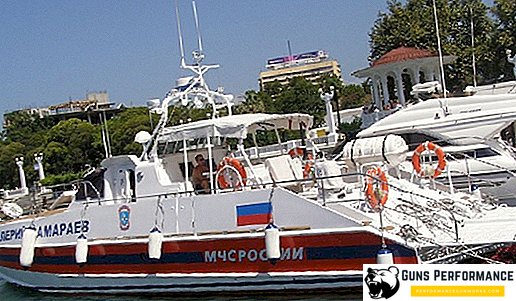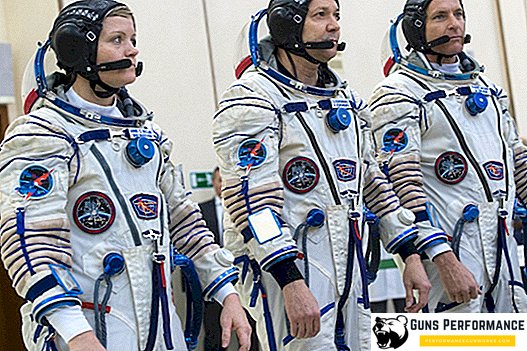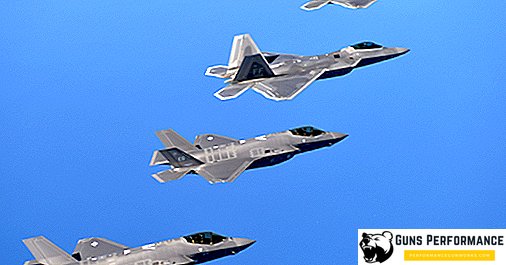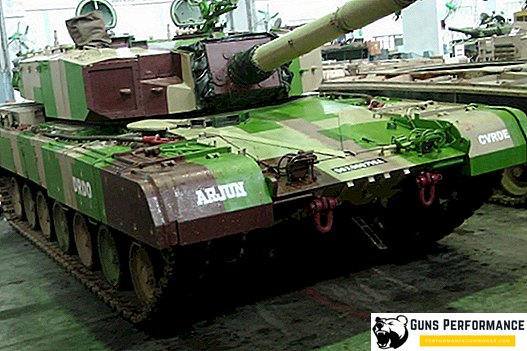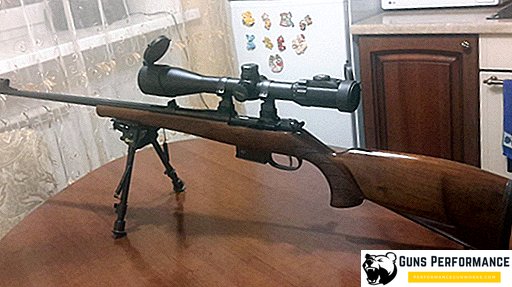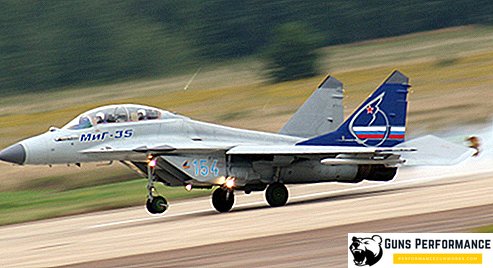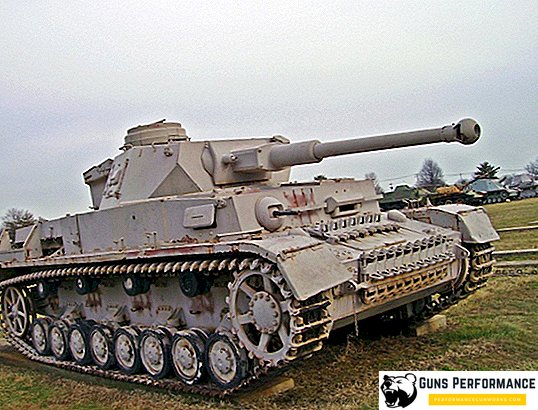
The Yak-7 is a Soviet single-piston fighter of the Second World War period, created at the Yakovlev Design Bureau on the basis of the Yak-7UTI training machine. The release of the aircraft began in late 1941 and lasted until 1944. Yak-7UTI, being designed to train flight personnel, has undergone further a number of amazing transformations and played a very important role in the history of the Great Patriotic War.
During production, eighteen different modifications of this fighter were developed, ten of which went into mass production. In total, more than 6,300 Yak-7 aircraft were produced. Since 1942, the "seven" on the front began to be gradually crowded out by the Yak-9 fighter, which later became the most massive Soviet military vehicle of the war period.
Despite some shortcomings, the pilots were good about the Yak-7. The quality of their manufacture was often higher than that of the Yak-1 fighters, on the basis of which they were created. Excellent flight characteristics and powerful weapons allowed the pilot not only to stand up for himself in battle, but also to get out of it as a winner.

Compared to the Yak-1, the Yak-7 fighter was more elaborated, a number of improvements were made to its design, which made this machine more manageable, safe and easy to maintain.
The Yak-7 was launched at four aircraft factories: No. 82 and No. 301 (Moscow), No. 21 (Gorky) and No. 153 (Novosibirsk).
The history of the Yak-7
At the end of the 1930s, feverish work was going on in the Soviet Union to create a new modern fighter. The best domestic design bureaus were attracted to it: Lavochkin, Mikoyan, Yakovlev. They planned to build a new car in large quantities, so almost immediately the question arose of the fastest possible development of a fighter in combat units. We needed a modern training aircraft, the characteristics of which would not be inferior to the new combat vehicles. Its development was entrusted with the design bureau under the leadership of Alexander Sergeevich Yakovlev.
Work on the new training aircraft began in 1939, the Yak-1 fighter was taken as the basis, and the designers of the design bureau were working on it at that time.
March 4, 1940, the Soviet government issued a decree on the creation of a training fighter on the basis of an I-26 prototype aircraft.
Tests of the training machine began in the summer of 1940, the aircraft showed very good flight qualities: at an altitude of 4500 meters it was able to reach a speed of 586 km / h. However, the UTI-26 (this name received a training fighter) was too difficult to pilot, which was unacceptable for novice pilots, so the car had to be finalized.
In addition, the first prototype of the fighter (it was called UTI-26-I) had a lot in common with the I-26 and therefore suffered from almost all of its flaws: the engine often overheated, there was often an emission of oil from the oil system, which splashed the entire front of the aircraft, including cab light. Especially unsuccessful was the chassis design. The diameter of the wheels did not match the weight of the aircraft, the locks that held the landing gear in the retracted or released position were extremely unreliable, which led to an accident during the tests. UTI-26-I had a strong tendency to capote.

Despite the identified shortcomings, they decided to launch the car into mass production, but after serious revision. The need of the Soviet Air Force training aircraft was so great that even the incomplete UTI-26-I was immediately sent to 11 IAP for retraining pilots on the Yak-1.
Improvements and improvements were made to the design of the second prototype - UTI-26-II. The aircraft landing gear underwent major changes: the diameter of the landing gear wheels was significantly increased, the struts and locks themselves, which fixed them in extreme positions, underwent alteration. The area of the stabilizer and rudder increased markedly - this significantly improved the handling of the aircraft. The center of gravity of the machine was shifted, the water radiator was increased and advanced. In the design of the machine made other, less significant changes. For example, the method of attaching a coca screw was changed, after which its installation began to take much less time. Modernization of the aircraft increased its weight to 2750 kg.
Despite the fact that the UTI-26-II looks very much like the Yak-1, it was structurally different machines. This caused some technological difficulties in production, because the Yak-1 and UTI-26 were to be made at the same factories. State tests of the aircraft took place in early 1941. The modified prototype of the fighter received a much higher mark from the military than the UTI-26-I. The need for a training aircraft was very acute, so in March 1941 the Moscow Aviation Plant No. 301 was transferred from the production of the Yak-1 to the production of the Yak-7UTI.

When the UTI-26 was just being created, no one could even assume that someday a full-fledged combat fighter would be created at its base. However, the huge losses of the Soviet Air Force at the initial stage of the war forced us to take such a step.
At the suggestion of the young designer Sinelytsikov, the aircraft were fitted with standard Yak-1 armament. Initially, this idea was perceived ambiguously by many, but Yakovlev gave the go-ahead to redesign one plane. A duplicate control was removed from it in the second cabin, an armorrest and fuel tanks were installed, protected by a protector with a neutral gas pumping system.
Tests of the "armed" version of UTI-26 began in June 1941, a few days before the outbreak of war. The report of the pilot who conducted the tests of the fighter, noted its best aerobatic qualities compared with the Yak-1. The new aircraft received the designation Yak-7. Combat use of the machine showed that the Yak-7 fighter surpasses the Yak-1 in survivability, armament and maneuverability.
After the start of the war, the alteration of the training aircraft in combat was also supported in the State Defense Committee. Already in August, the relevant decrees were issued. Serial production of the Yak-7 aircraft began at once in two plants: No. 301 and 153. At this time, the evacuation of aviation enterprises and scientific research institutes took place, so the Yak-7 government decided not to carry out the tests and limited it to factory tests.
In July 1941, the Yakovlev Design Bureau was evacuated to Saratov, where designers literally in a matter of days, in a proactive manner, developed a cannon modification of a fighter - the Yak-7M, installing ShVAK cannons in the wing. Also on the aircraft were installed launchers for rockets. To do this, however, had to reduce the volume of fuel tanks. In October 1941, flight tests began a new fighter.

During serial production, several serial modifications of the fighter were made:
- Yak-7. The basic modification of the machine, the release lasted from September to October 1941. A total of 62 units were manufactured.
- Yak-7A. Modification of the fighter, the release of which began in January 1942. The aircraft was equipped with a new radio station, minor changes were made to the airframe design. Production continued until May 1942, a total of 277 Yak-7A units were produced.
- Yak-7b. The most massive modification of the machine, its production began in May 1942 and lasted until December 1943. During this period, 5120 aircraft were released. The Yak-7B had two UBS machine guns instead of ShKAS, a retractable tail landing gear, and since mid-1942 and a new engine, the M-105PF. The new power plant, as well as a number of other changes made it possible to increase the speed of the fighter to 532 km / h from the ground. On the last series of this modification, the gargrot was removed, the fuselage contours and its sealing were improved, which made it possible to further increase the speed characteristics.
- Yak-7B. Training fighter, which was made by removing weapons from the serial Yak-7B. It was produced from May 1942 to December 1943. It was made 597 aircraft.
- Yak-7-37. Modification, armed with a 37-mm cannon MPSH-37 and two machine guns UBS. This fighter had a slightly different cockpit layout, slats slightly larger tail wheel.
An interesting modification of the fighter is the Yak-7R, where the letter "P" stands for "reactive". This machine was equipped with a combined power plant consisting of a piston motor and several jet engines.
On the basis of the Yak-7 fighter, they tried to create a long-range fighter (Yak-7DI), a high-altitude interceptor (Yak-7DI), to install an air-cooled engine on the aircraft. But these cars did not go to the series.
Fighter Yak-7 took part in all major battles of the Second World War. The additional cabin of this aircraft was often used to transfer personnel or cargo to new locations. In the rear compartment it was possible to install an additional fuel tank. Often in the back cockpit was installed photographic equipment, and the Yak-7 turned into a reconnaissance vehicle.

Description of the design of the Yak-7
The Yak-7 is a single-seater, single-engine monoplane fighter with a low wing and a mixed design: in the manufacture of the machine, both duralumin and wood with a canvas were used. The crew consisted of one person.
Like other fighters of the Yak family, the Yak-7 power cage was made of chromansil tubes, to the front of which the engine mount was attached. Advantageous difference of the Yak-7 from other Yakovlev machines was that the removable engine frame allowed the installation of other engines on the aircraft. The front cover of the fighter was metal, and the tail of the Yak-7 was sheathed with plywood.
The cockpit was in the central part of the fuselage. The Yak-7 was created on the basis of the Yak-7UTI training aircraft, which had two cabins - for the pilot and instructor. On the combat aircraft, the second cabin was removed, in its place was an additional compartment, closed by a lid. It could be used to transport goods, another person, or install an additional gas tank.
The wing of the Yak-7 had a mixed construction: two dural spars, wooden ribs and a working skin made of plywood. The wing was additionally plastered.
The tail of the Yak-7 consisted of a wooden keel and a stabilizer, the rudders were made of duralumin and sheathed in canvas. The plane had a tricycle retractable landing gear, which consisted of two main racks and tail support. On the first modifications of the machine, the tail wheel did not retract in flight. Like other Yakovlev fighters, the Yak-7 had a chassis with air-oil damping, cleaning and production of the chassis was carried out by the pneumatic system. In the retracted position, the chassis were covered with flaps.

Initially, the Yak-7 fighter was equipped with an M-105P water cooling engine (1050 hp), then more powerful engines were installed on the aircraft (M-105PA, M-105PF). The fuel tanks of the car were retrofitted and located in the wings: two in the wing consoles and another in the center section. The aircraft had an inert gas pumping system, which increased its fire safety.
The oil radiator was located in the front of the fighter in a special tunnel under the engine, the water radiator was installed in the central part of the fuselage just behind the pilot's cabin. In winter, antifreeze was added to the water, and gasoline was added to the oil.
The training Yak-7UTI did not have any weapons at all, the Yak-7 received a 20-mm ShVAK cannon, which was in the collapse of the engine, as well as two ShKAS machine guns (7.92 mm). Gun ammunition was 130 rounds, machine guns - 1 thousand rounds of ammunition. The modification of the Yak-7A could hang several missiles or 100 kg of bombs. The most massive modification of the Yak-7B fighter was armed with one ShVAK cannon and two 12.7-mm UBS machine guns, which greatly increased the firepower of the machine. The combat reports noted that after the installation of more powerful UBS machine guns, the Yak-7 became effective for work on both aerial and ground targets.

Characteristics TTK Yak-7
Flight performance of the Yak-7 fighter:
- wing span, m - 9.74;
- length, m - 8.37;
- height, m - 2.75;
- weight, kg - 3370;
- engine - ASH-82;
- power, l. with. - 1330;
- Max. speed, km / h - 615;
- practical range, km - 825;
- practical ceiling, m - 10,200;
- crew, people - one.


